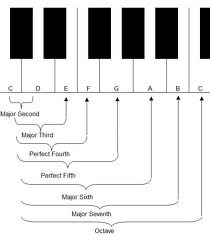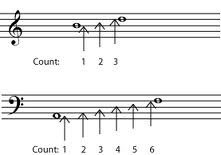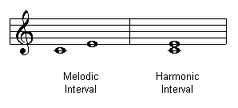An interval in music is defined as the distance in pitch between two notes.
We use the word “interval” to describe in greater detail how close or how far apart two notes are from each other.
Intervals can range anywhere from unison (same note) to an octave (8th).

| ✅ The best self-study music theory book loved by all my readers and students. |
Intervals on the Piano
Here is what each of these intervals look like on the piano.

Before going any further, take a moment to first get acquainted with the concept of steps and skips.
Steps and skips are very much the same idea. They are describing the distance between two notes.
However, we do need a more definite language to explain exactly how far apart two notes are.
Steps = 2nd Intervals
The steps you have learned about are now going to be renamed 2nds. How did we get this?
We count the first note as “1” and the second note as “2”. The distance between the two notes is a second.
Skips take a little bit more work to describe because there are a variety of skips we can encounter.
Skips = 3rd, 4th, 5th, 6th, 7th, 8th Intervals
The easiest and most familiar skip you know is actually a 3rd.
Again, we figure this out by counting the first note as “1”, the next line or space as “2”, and the last note as “3”. The distance between the two notes is a third.
How to Name Intervals
To decide what an interval is, you count both notes on the music staff and all the lines and spaces in between.
You may find it helpful to use the tip of your pencil to guide you (pointing at each note, line or space) as you practice this.
- Start with the bottom note and count it as “1”.
- Count the following lines or spaces (in between the two notes) in succession as “2”, “3”, etc. until you reach the last note.
- The last note should be counted as the last number. This last number is used to describe the interval.

The only exception to this rule is when two notes are exactly the same pitch. In this case, we would say the interval is unison.
Something else to note is that an 8th interval can also be called an octave.
Even-Numbered Intervals
The even-numbered intervals always appear on the staff as one space note and one-line note.

This includes all 2nds, 4ths, 6ths, and octaves (8ths). Isn’t that interesting?
Odd-Numbered Intervals
The odd-numbered intervals always appear on the staff as two-line notes or two space notes.

Unisons, 3rds, 5ths, and 7ths are what this all includes.
Melodic Intervals
Not to confuse you here, but intervals can also be described by whether they sound together or apart.
A melodic interval involves two notes that sound separately. In other words, you play each note one at a time.
I like to think of this as being similar to a melody line. The melody “Happy Birthday” uses notes that are played separately, never together.

Harmonic Intervals
When two notes sound together, they are called harmonic intervals. The word “harmonic” is similar to “harmony”. This is exactly how I like to think of this.
Harmony is hearing how two or more notes blend together. Each note must be played together (kind of like a chord) in order for this to happen.
Why Bother With All of This?
Knowing what an interval in music gives us a more effective language to communicate with.
It is a way of describing exactly what we are looking at on the page. This terminology has a standard use across the world.
Anywhere you go, you should be able to now talk about intervals well with a full understanding of each other.
Recommended Music Theory Books
✅ The best self-study music theory book loved by all my readers and students.

Any books to help me understand intervals ?
Thank you for your summary of Music Intervals
I am studying music intervals at the moment and understand the basic .
Can you explain in relation to the Major 2nd,3rd 6th and 7th, why is is called major, i.e. what is so major about theses intervals that they need to be called Major, and why is a Diminisihed 5th not called a Minor 5th.
Thank You
The difference between Major (bright, happy sound), Minor (sad, dark sound), Diminished (smallest possible form) and Augmented (largest possible form) intervals is the number of half steps in between. All interval types give a very different tone quality, nuance and sound that can be used in a variety of creative ways.
Never really knew what an interval was. Now this has made it much clearer.
Still not quite totally clear about diminished and augmented intervals
Would D natural to F sharp be an augmented third?
And A natural to E flat a diminished 5th?
Many thanks
Intervals are a helpful concept. Once I learn the intervals of a song’s Melody, I can easily change the key. Your website is chockablock full of insights into music theory to better understand and enjoy music. Thank you.
The idea of the unison interval is a puzzle. Can you play the unison interval simultaneously on a piano?
Moreover, I don’t understand it’s purpose. It seems to confuse intervals with notes. Musicians might refer to returning to the one. I’d prefer they said root, or to the first “note.” Making reference to chord progressions as one, four and five seems to be the notes in the scale, not the distance between the notes. The distance between the chords is zero, three and four.